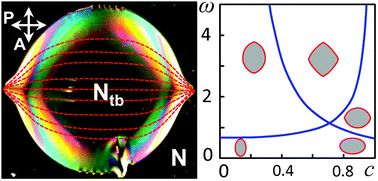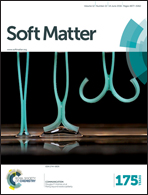Interfacial and morphological features of a twist-bend nematic drop†
Abstract
In this experimental and theoretical study, we examine the equilibrium shapes of quasi-two-dimensional twist-bend nematic (Ntb) drops formed within a planarly aligned nematic layer of the liquid crystal CB7CB. Initially, at the setting point of the Ntb phase, the drops assume a nonequilibrium cusped elliptical geometry with the major axis orthogonal to the director of the surrounding nematic fluid; this growth is governed principally by anisotropic heat diffusion. The drops attain equilibrium through thermally driven dynamical evolution close to their melting temperature. They are associated with a characteristic twin-striped morphology that transforms into the familiar focal conic texture as the temperature is lowered. At equilibrium, large millimetric drops are tactoidlike, elongated along the director of the surrounding nematic fluid. This geometry is explained using a mathematical model that features two dimensionless parameters, of which one is the structural cone angle of the Ntb phase and the other is the relative strength of mismatch elastic energy at the drop's interface. Both parameters are extracted from the observations by measuring the aspect ratio of the equilibrium shapes and the inner corner angle of the cusps.


 Please wait while we load your content...
Please wait while we load your content...